How to Use Food to Manage Your Cholesterol

If you are looking for ways to lower your cholesterol, you may want to start by looking at what you eat. You may be thinking this means removing certain foods from your diet and while that is true, using diet to manage cholesterol also means making sure you are eating the foods that help bust cholesterol.
September is National Cholesterol Education Month and if you are one of the 102 million American adults the Centers for Disease Control indicates has high cholesterol, now is the time to take steps to learn to manage your cholesterol and lower your risk of heart disease and stroke. The first step is to get your cholesterol tested as you may not even realize there is a problem since high cholesterol doesn’t have any symptoms. Then, if your cholesterol levels are outside the recommendations, take action to manage it with diet, exercise, and medication. While your doctor can help you determine the right strategy for your situation, everyone can benefit from these tips for using food to manage your cholesterol.
Open with Oatmeal
When it comes to cholesterol, oats, which are packed with soluble fiber can make a big difference without requiring big changes. According to Harvard Medical School, the current recommendation for dietary fiber are 20 to 35 grams a day with 5 to 10 of those grams coming from soluble fiber. Choosing a bowl of oatmeal for breakfast will get you about 2 grams of soluble fiber which is a great way to start off your day.
Eat Fish
The fatty acids found in fish, omega-3s, are good for your heart. They can help reduce blood pressure and for those with known heart conditions, eating fish or taking fishing oil supplements can reduce the likelihood of dying suddenly from a cardiac event. The American Heart Association recommends that everyone eats a 3.5 ounce serving of fatty-acid rich fish twice a week. For the biggest benefit, choose fatty fish like mackerel, herring, salmon, or halibut and bake your fish instead of frying it.
Go Nuts
Not only are nuts good for your taste buds, they are also good for your heart. According to Harvard Medical School, simply eating 2 ounces of peanuts, almonds, or other nuts a day can help lower your LDL or bad cholesterol by as much as 5%.
Feast on Fruit
Fruits like apples, grapes, berries, and citrus are also high in soluble fiber. Adding these to your diet daily can help appease a sweet tooth and lower your bad cholesterol.
Choose Beans
Beans are another good source of soluble fiber and they have the added benefit of making you feel full longer which can help curb appetite and cravings. Beans are also incredibly versatile and you can choose from a wide variety ranging from kidney beans to chickpeas to edamame/ soy beans. Use beans to add volume to soups and stews, fill burritos or wraps, or to replace other less heart healthy side dishes.
Related Articles:
- Getting Your Kid to Eat Healthy (fillyourplate.org)
- Getting Your Kids to Eat Healthy is as Easy as 1,2,3 (fillyourplate.org)
- How to Keep Kids Healthy this Summer (fillyourplate.org)
B is for Breakfast

It shouldn’t be news that breakfast is the most important meal of the day and yet many of us are still skipping breakfast. So we wanted to take this opportunity to talk about why breakfast is so important since September is National All-American Breakfast Month.
According to the USDA, the benefits of breakfast are clear, especially when it comes to our kids. Eating a balanced breakfast:
- Helps improve standardized scores
- Helps improve reading and math abilities
- Improves behavior and memory
- Increases the ability to pay attention and solve problems
- Decreases the chances of being overweight
Basically, breakfast gives your body the nutritional boost you need to jumpstart your day. Here are a few other reasons to make breakfast a priority.
Eating Breakfast Helps Manage Your Weight
Research indicates that skipping breakfast increases your likelihood of becoming overweight or obese. Experts believe that when we don’t start our day off properly, we end up eating more calories over the course of the day by choosing high calorie lunches and lots of snacks. Additionally, when you skip meals you send the message to your body that you are starving. You body then goes into starvation mode which means it holds on to any extra fat and converts extra calories into fat because it thinks you are starving and wants to conserve resources to ensure your survival.
Eating Breakfast Makes You Smarter
As the benefits listed above show, there are real, lasting benefits in our ability to learn, solve problems, remember, and perform other cognitive tasks. Simply eating breakfast everyday can boost test scores and improve grades in kids. By giving our brain the fuel it needs to function right at the start of the day, we are better able to concentrate and use our memory.
Eating Breakfast Helps Manage Your Mood
Another benefit of breakfast that many people overlook is the affect it can have on our mood. When our body gets hungry, it causes shifts in our mood. Many people get grumpy when they are hungry and it isn’t unusual to find that you are quicker to anger when you need to eat. But giving your body the boost it needs right out of the gate can do more than just make you better to be around, it can also improve your attitude and make you more motivated to accomplish the tasks you need to tackle.
Eating Breakfast Elevates Your Energy Level
One other big benefit of giving yourself the breakfast boost is that it also elevates your energy level. This means you will have the energy to tackle those tasks and all that extra motivation won’t wind up going to waste.
Of course, not all breakfast choices are created equally. It is important to remember that a hasty meal packed with sugar won’t provide the same benefits as a breakfast high in protein and complex carbohydrates. Focusing on a breakfast that is high in both fiber and protein and low in sugar is the best bet.
To fill your plate with some delicious breakfast choices, try one of these breakfast recipes from FillYourPlate.org.
- Arizona Quiche
- Boss’s Baked French Toast
- German Apple Pancake
- Hickman’s Jalepeno Bacon & Egg Bake
- Overnight French Toast
- Virgin Waffles
- Zesty Papa Protein Scramble
Related articles
- How to Build a Better Breakfast (fillyourplate.org)
- 20 Brilliant Breakfast Ideas for Holiday Mornings (fillyourplate.org)
- Breakfast in a Corn Field (fillyourplate.org)
5 Ways to Bring the Farm to School
 (Photo courtesy of National Farm to School Network)
(Photo courtesy of National Farm to School Network)
In 2010, Congress designated October as National Farm to School Month celebrate those who practice growing their own food and honor the farmers who provide food, fiber, and fuel to the rest of us. The Farm to School Programs play a crucial role not only in helping children understand where their food comes from, but also as a means to improve child nutrition. Implementing this program is a great opportunity for us to educate children on where their food comes from while also helping to stimulate local economies.
What is Farm to School?

Farm to School or Farm to Child Care programs enrich the connection that communities have with fresh, healthy food and local food producers by changing food purchasing and education practices at schools and preschools.
This initiative gives students access to healthy and local foods at meal times as well as providing innovative educational opportunities through techniques found in flourishing school gardens, creative cooking lessons and by experiencing farm field trips. Local farmers increase their ability to stay on the land through expanded distribution outlets and by building hands-on relationships with the communities that they serve.
What’s happening in Arizona?

Arizona has a lot to celebrate! Since 2011, the Arizona Department of Education, Health and Nutrition Services Division (HNS) has worked to connect school food buyers with Arizona producers by offering regional farm tours, regional buyer-supplier meetings and training to schools on topics such as local procurement, food safety, and basics in school gardening. The latest USDA Farm to School Census reported that 31% of Arizona public schools engage in some kind of farm to school activity. Related activities may include: building a school garden, visiting a farm, serving locally produced food in school meals, taste education with local foods, inviting a farmer to school, writing to a farmer, rancher or dairyman or learning about Arizona agriculture through classroom activities.
How can YOU celebrate National Farm to School Month?
HNS encourages parents, teachers, food service professionals, administrators, and community leaders to be positive role models for our students. Here are suggestions on how you can celebrate National Farm to School Month:
1. Remind teachers and nutrition educators to invest in Arizona Farm Bureau’s Agriculture in the Classroom resources this October to help engage students in learning more about where their food comes from. Teachers should pay special attention to their Aggie Pen Pal Program, and can click here to register now.
2. Learn about how to start a school garden, garden food safety and find peer written lessons to help teachers incorporate agriculture into their classrooms with the Agricultural Literacy Programfrom the University of Arizona Cooperative Extension in Maricopa County. Look for the Locally Grown lesson located on their home page.
3. Coordinate taste testing with something locally produced in your area for a classroom or after school program. Check out the Arizona Grown website for more information about Arizona’s seasonality, farmers’ markets, U-pick farms and nurseries near you.
4. Visit your local farmers’ market. Buy something you’ve never tried before, cook it and share with your family and friends. For information about where the nearest market is and other locally owned and operated businesses, go here. Or, go to Arizona Farm Bureau’s Fill Your Plate and select their Farmers’ Market listing, containing one of the most comprehensive lists of the state’s farmers markets that’s searchable by city and county.
5. Win $1,000 for your community! Anyone who fills out a “Share Form” on the National Farm to School website during the month of October will be entered to win a drawing for $1,000 to spend on a farm to school project in their community! For more information contact Cindy Gentry, Arizona State Lead for the National Farm to School Network at cgentry2@cox.net.
For more information on Arizona Farm to School, please visit our Arizona Farm to School or School Garden pages, our Facebook page or contact ArizonaFarmtoSchool@azed.gov.
Can Prunes Help Whittle Your Waistline?
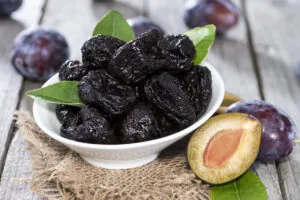
If most of us think of prunes at all, we think of them as something senior citizens eat because of their high fiber content. But a new study may have everyone talking about prunes as the next weight loss “superfood”. According to research from the University of Liverpool, eating a couple prunes each day can help keep you from getting hungry and make it easier to lose weight.
The intent of the study, which included 100 participants who were either overweight or obese, was to determine the effect of prunes on weight loss. In addition to being overweight, all participants were also low-fiber consumers. The goals of the study were to understand if including prunes as part of a weight-loss diet had any effect on weight reduction, to determine if people who were low fiber consumers could tolerate eating large quantities of these high fiber fruits, and to see if eating prunes had any effect on appetite.
The study spanned a 12 week timeframe where participants were separated into two groups. One group consumed a specific amount of prunes everyday as part of their regular weight loss diet. The other group was given advice on how to select healthy snacks, but there was no mandatory intake of prunes.
The findings indicate that eating just 5-6 grams of prunes everyday has a demonstrable effect on weight loss. Those in the prune group lost almost twice as many pounds over the 12 week period as their healthy snack peers. On average, the prune group members lost 2.5 kg or about 5.5 pounds while their non-prune eating peers averaged about 1.5 kg or 3.3 pounds lost over the length of the study.
In addition to the difference in weight loss, those participants in the prune group saw an increase in their rate of weight loss in the final weeks of the study. They also reported experiencing greater feelings of fullness. None of those in the prune group had any difficulty tolerating the high fiber food even though they generally ate low fiber diets.
The research team believes that one of the main reasons the prune group lost more weight was because the high-fiber prunes helped reduce hunger and control appetite by making participants feel fuller, longer.
These findings indicate that including prunes as part of an overall weight loss/management strategy may help those who are overweight or obese lose more weight than they would by following the same diet without the prunes. This will change the conventional wisdom that generally omits dried fruit from weight loss and weight management diets.
For ways to get some prunes onto your plate, try these great recipes featuring the fiber-rich dried fruit.
- Prune and Olive Chicken
- Banana and Prune Muffins
- Breakfast Porridge
- Green Chicken Kozani
- Brandied Prune and Chocolate Chunk Cookies
- Duck with Prunes in Red Wine
- Braised Goat Shanks with Prune, Shallot, Brandy Reduction
- Oven Roasted Prunes Wrapped with Pancetta
- Pork Chops with Apple Cider, Walnuts, and Prunes
- Spiced Pumpkin Prune Muffins
Related articles
- Are Cherries the New Super Fruit? (fillyourplate.org)
- 10 Ways to Fill Your Plate with Fruits and Vegetables: Part 1 (fillyourplate.org)
- What to Do With All that Fruit (fillyourplate.org)
Celebrate Arizona Sweet Corn this Summer!
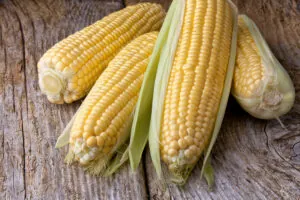
Nothing is quite as good at a backyard barbecue as a fresh, juicy ear of delicious Arizona grown sweet corn. We are in the early part of the sweet corn harvest as ears of corn from the farms in the central part of the state start showing up in farmer’s markets and in grocery store bins. The local sweet corn season spans the entire summer, running from late May all the way into September thanks to the farms in the North and South parts of the state which will start harvesting in mid-July. There is no doubt that the sweet corn season ushers in summer fun like no other food. You can find a wide variety of farmers selling sweet corn this summer on Arizona Farm Bureau’s Fill Your Plate, just click on “Find a Farm Product” and select corn from the drop down menu.
One of the best reasons to eat local, Arizona grown sweet corn this summer is that it is packed with nutrients as well as flavor. Sweet corn provides vitamins A and C, potassium, and thiamine. It is cholesterol free, packed with antioxidants, and full of fiber. It is also a whole grain and who doesn’t need more whole grains in their diet!
Get in the mood to celebrate sweet corn this summer by checking out our new “Celebrate Arizona Sweet Corn” video which tells the story of sweet corn in Arizona agriculture and features the hardworking local farmers that grow it.
Ever wondered where sweet corn came from or how long we have been growing it? To answer those and many other questions about the origins of sweet corn, here are some of the facts we find more interesting about this delicious and nutritious vegetable.
- Corn is native to the Americas and we know it has been domesticates since at least 8,000 B.C.
- Corn was originally used as a more generic term that related to whatever grain was most prevalent in a region. This meant that corn in England was actually wheat and corn in Scotland and Ireland was actually oats.
- Corn as we know it today got its name from the early American settlers.
- Sweet corn, which is a whole grain, is the third most important crop in the world.
- Within each ear of corn you will find between 500 and 1000 kernels of corn.
- There will always been an even number of rows of kernels on each cob, usually 16.
- Within an ear of corn, there is one piece of silk for each kernel of corn.
You can also go beyond the cob and try some of these delicious recipes featuring sweet corn.
- Baked Corn Dish
- Chili Corn Bread
- Chicken and Wild Rice Soup
- Chicken Tortilla Soup
- Corn and Black Bean Salsa
- Corn and Green Bean Casserole
- Old Mexico Style Pozole
- Sauteed Zucchini with Corn and Chives
- Tamale Pie
Related articles
- What’s in Season in December? (fillyourplate.org)
- What Is On Your Christmas Day Dinner Plate? (fillyourplate.org)
- How Do You Eat Your Corn? (fillyourplate.org)
Mad about Mangoes
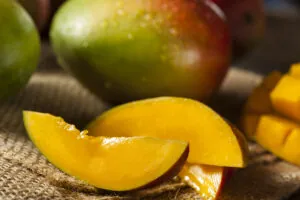
Who doesn’t love the velvet texture and sweet juicy flavor of a perfectly ripe mango? This month, we wanted to shine a light on this colorful fruit that is as healthy as it is delicious. Mangoes are packed with anti-oxidants, fiber, vitamin A, and vitamin C. But even with all that nutrition, most people eat them simply because they taste so good. Here are some of the ways you can use mangoes this month to punch up the flavor and add a little color when you fill your plate.
- Mango Chutney
- Frozen Mango Margarita
- Chipotle Mango BBQ Chicken
- Mambo Chicken with Mango Salsa
- Seared Mahi Mahi with Grilled Mango Pineapple Salsa, Green Rice, and Black Beans
- Coconut Water Smoothie with Mango, Banana, and Strawberries
- Mexican Mango Cake
- Seared Tuna with Mango Salsa
- Grilled Jerk Chicken with Mango Cilantro Salsa
- Jerk Turkey Burgers with Mango Slaw
- Strawberry Mango Mesclun Salad
- Avocado Mango Salsa
- Mango Blueberry Muffins with Coconut Streusel
- Mango-licious Tilapia
- Spicy Indian Chicken and Mango Curry
- Bourbon Mango Pulled Pork
- Spicy Mango Sweet Potato Chicken
- Chicken and Pasta in Mango Cream Sauce
- Curried Mango Chicken
- Buttermilk Mango Berry Crumb Cake
- Cucumber Mango Salsa
- Curried Tilapia with Mango Salsa
- Spicy Black Beans with Rice and Mangoes
- Garlic Lime Grilled Chicken with Mango Salsa
- Coconut Chicken Fingers with 30 Minute Mango Chutney
- Spicy Coconut Shrimp with Spicy Mango Basil Salsa and Lime Jasmine Rice
- Mango Ice Tea
- Crunchy Jicama and Mango Salad with Chile and Lime
- Coconut Lime Cheesecake with Mango Coulis
- Mango Cardamom Bread Pudding
- Mango, Peach, and Pineapple Salsa
- Chicken Avocado and Mango Salad
- Grilled Poblano Pepper and Mango Quesadillas
- Caribbean Grilled Crab Cakes
- Chili and Lime Grilled Mangoes
- Mango Barbecued Chicken
- Mango Shrimp
- Blueberry and Mango Fruit Salad
- Banana and Mango Apple Rice Kugel
- Chipotle Tilapia Tacos with Mango Cilantro Salsa
- Two Bean and Mango Salad
- Mango Custard Pie
- Mango Guacamole
- Mango Pineapple Salad with Mint
- Mesclun and Mango Salad with Ginger Carrot Dressing
- Grilled Sea-Bass with Jalapeno Mango Salsa Recipe
- Ceviche Shrimp and Grouper with Serrano Chiles, Mango Smoked Tomatoes, and Crispy Plantain Chips
- Mango Peach Sangria
- Mango Black Pepper Glazed Grilled Pork Chops with Mango Black Bean and Green Onion Salsa and Yucca Fries
- Mango Sorbet
Related Articles:
- Get to Know these Neglected Grains (fillyourplate.org)
- Hey Kids! What’s Cooking? (fillyourplate.org)
- Pasta Primer (fillyourplate.org)
Crazy for Cauliflower!

Admit it! When you think about the kinds of vegetables you crave, cauliflower isn’t likely to be at the top of your list. But this cousin to both broccoli and cabbage might just surprise you with some of the delicious dishes that can be made from it.
Cauliflower, like many of the other cruciferous vegetables, can be a great contributor to a healthy diet. It is believed to help detox the body, aid in addressing inflammation issues, and provide some protection against certain types of cancers including those affecting the bladder, breast, and colon. Unfortunately, because cauliflower is less popular that it’s more mainstream relatives, there isn’t a significant body of knowledge available to support any specific claims related to health benefits.
However, it doesn’t take research results to understand why cauliflower should make its way onto your menu several times each month. A single 3.5 ounce serving of cauliflower has about 25 calories and provides:
- 5g carbohydrates
- 1.9g sugar
- 2g dietary fiber
- 0.3g fat
- 1.9g protein
- 92g water
- 0.667 mg pantothenic acid (B5) (13% of RDA)
- 0.184 mg vitamin B6 (14% of RDA)
- 57 μg Folate (B9) (14% of RDA)
- 48.2 mg vitamin C (58% of RDA)
- 0.08 mg vitamin E (1% of RDA)
- 15.5 μg vitamin K (15% of RDA)
In addition, it provides calcium, iron, magnesium, manganese, phosphorus, potassium, and zinc.
Cauliflower can be eaten in a variety of ways, but for best results, sauté them in a vegetable oil high in Omega-3s. While it can also be steamed and boiled, it is very easy to overcook cauliflower using these methods which can result in a mushy, tasteless mess. If you are interested in finding out why we are crazy for cauliflower this month, check out some of these great recipes that showcase this very healthy veggie.
- Abby’s Yummy Veggie Pizza
- Roasted Garlic Cauliflower
- Over Roasted Cauliflower with Olive Oil, Garlic and Lemon Juice
- Just Like Loaded Baked Potatoes Cauliflower
- Cream of Cauliflower Soup
- Cauliflower Mac n Cheese Casserole
- Cauliflower Gratin
- Roasted Cauliflower and Broccoli
- Cauliflower Supreme
- Cauliflower Fritters
- Cauliflower Soup
- Garlic Mashed Cauliflower
- Sausage Cauliflower Spaghetti
- Curried Cauliflower
- English Cheddar Cheese Gratin
- Broccoli and Cauliflower Salad
- Roasted Parmesan Garlic Cauliflower
- Chicken Tetrazzini with Cauliflower
- Greek Cauliflower
- Cauliflower with Avocado Cilantro Dip
- Thai Red Curry with Vegetables
- Cauliflower Onion Linguine
- Fried Cauliflower
- Ham and Cauliflower Casserole
- Oven Roasted Cauliflower with Tumeric and Ginger
- Cajun Cauliflower in Garlic Sauce
- Roasted Cauliflower and Leek Soup
- Cauliflower and Ham Crustless Quiche
- Cauliflower and Egg Salad
- Curried Cauliflower, Chickpeas, and Tomatoes
You can find locally grown cauliflower from these Arizona Farm Bureau Members:
- Bathtub Spring Farm in Nutrioso
- Big Happy’s Farm in Mesa
- Crooked Carrot Farm in Queen Creek
- Desert Roots Farm in Queen Creek
- Schnepf Farm in Queen Creek
- Tonopah Rob’s Vegetable Farm
Learn more about Growing Cauliflower by watching this video.
Related articles
- 30 Things to Do With Broccoli (fillyourplate.org)
- 20 Ways to Use Brussels Sprouts (fillyourplate.org)
- 27 Easy Recipes for Soup (fillyourplate.org)
20 Ways to Use Brussels Sprouts
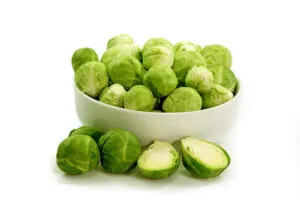
Despite its close ties to other popular vegetables like broccoli, Brussels sprouts are not generally found at the top of the list of our favorite vegetables. This under-appreciated veggie is one of our Vegetables of the Month for April and we hope that getting to know it a little better might inspire you to use it to help fill your family’s plates this month. Here is a look at where Brussels sprouts came from and some delicious ideas for including them in your April dishes.
Considered a “leafy green,” Brussels sprouts are a member of the same family as cabbages and actually resemble miniature versions of their more popular cousins. Although the history of the Brussels sprout is not entirely clear, it is believed that they were originally cultivated in ancient Rome and have been grown since the 1200’s in Belgium where they are very popular. They take their name from Brussels, one of Belgium’s largest cities and they were traditionally grown across Northern Europe because they thrive in colder climates. They spread from Belgium to the Netherlands and then do through the rest of Europe before becoming known around the world.
Brussels sprouts are not only cousins to cabbage, they also belong to the same family as some of the other more popular leafy greens like kale, collards, broccoli, and kohlrabi. They provide a good source of vitamins A and C and provide both dietary fiber and folic acid. Additionally, Brussels sprouts, like broccoli, contain two specific chemical called sulfuraphane and indole-3-carbinol, which are believed to help prevent cancer.
Brussels sprouts can be prepared in a variety of ways including boiling, sautéing, roasting, grilling, steaming, and stir-frying. To retain the highest nutritional profile, steaming or stir-frying is the best ways to prepare them. Overcooking can result in an unpleasant taste and smell which most people do not like. To get the best flavor, roasting is the best method of preparation. As you can see in the recipes provided below, Brussels sprouts go well with bacon, pistachios, brown sugar, balsamic vinegar, and mustard.
This month, give Brussels sprouts a second chance to become a family favorite. Here are 20 delicious dishes you can use to try them out.
- Roasted Brussels Sprouts
- Shredded Brussels Sprouts
- Brussels Sprouts with Bacon, Garlic, and Shallots
- Breaded Brussels Sprouts
- Brussels Sprouts with Browned Garlic
- Caramelized Brussels Sprouts with Pistachios
- Balsamic Roasted Brussels Sprouts
- Sweet and Sour Brussels Sprouts
- Parmesan Brussels Sprouts
- Roasted Potatoes, Parsnips, Carrots, and Brussels Sprouts
- Romano Topped Brussels Sprouts
- Chile Rubbed Chicken Breast with Kale, Quinoa, and Brussels Sprouts
- Chicken with Brussels Sprouts and Mustard
- Kielbasa with Brussels Sprouts
- Brussels Sprouts Gratin
- Brussels Sprouts Salad
- Penne with Brussels Sprouts and Bacon
- Pan Fried Brussels Sprouts
- Roasted Cauliflower, Brussels Sprouts, and Jerusalem Artichokes
- Spicy Brussels Sprouts
Related articles
- Get to Know Your Leafy Greens (fillyourplate.org)
- Using Food to Fight Stress (fillyourplate.org)
- Better Know a Bean (fillyourplate.org)
Using Food to Fight Stress

Research has shown that there is a complex link between our central nervous system and our gut which may eventually help to explain why so many of us are prone to unhealthy eating decisions when our stress starts to boil over.
In fact, according to research conducted by the Center for Disease Control (CDC), the foods we choose to eat when we are feeling stressed are generally high in all the things we don’t need them to be including calories, sugar, and fat. This means that stress, all by itself, increases the chances of becoming overweight.
April is National Stress Awareness Month which provides each of us with an excellent opportunity to look at how much stress we have in our lives, how well we are managing it, and what we can do better in order to mitigate the damaging effects caused by chronic stress. We also thought it was an excellent opportunity to talk about the role food can play in helping you to manage your stress. While stress can make us crave foods that are not beneficial to meeting our nutritional needs, the foods we choose can also have a significant impact on our stress.
This month, rather than focusing on trying not to make unhealthy eating choices when you are stressed, approach from a different angle and explore the ways that you can use food to decrease and manage your stress. There are certain foods that are natural mood enhancers. Eating these foods can help keep you calm even in the most stressful situations. There are other beneficial foods that actively work to repair the damage chronic stress does to your body. Incorporating more of these kinds of foods into your daily diet will help make you naturally more resilient in stressful situations while also giving your body the support it needs to repair the damage stress has caused.
There are specific types of foods that offer stress mitigation and management benefits:
- Foods that are high in vitamins boost the immune system and help combat the damage caused by stress
- Foods that are high in potassium, folate, and/or magnesium are also excellent at making you more resilient when it comes to the effects of stress
- Foods that contain high amounts of healthy fats like Omega-3s help fight stress and the damage it causes
- Foods high in fiber are also beneficial to managing stress and repairing any damage it has done
- Foods high in protein help manage stress
You can easily incorporate more of the foods that fit into these categories into your diet to safeguard you against the damaging effects of stress.
Here are some examples of the kind of foods that fit into each group.
- High in Vitamins – blueberries, almonds, broccoli, beef, oranges, milk
- High in Potassium, Folate, and/or Magnesium – leafy greens, asparagus, spinach, avocados, apricots, broccoli, artichokes and arugula
- High in Omega-3s – walnuts, tree nuts, fish and spinach
- High in Fiber – whole grains, artichokes, oats, berries, oats, and broccoli
- High in Protein – tuna, beef, and milk
Related articles
- March Toward Better Health (fillyourplate.org)
- Better Family Bonding Through Baking (fillyourplate.org)
- 50 Fun Things to Do With Sweet Peppers (fillyourplate.org)
30 Things to Do with Broccoli
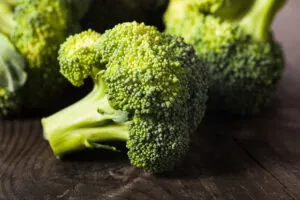
When it comes to nutrition alone, there is no question that broccoli is one of the foods everyone should be eating more often. A member of the cabbage family, broccoli can be served a number of ways, the most common being boiling, steaming, or serving it raw. It is very low in calories, with only 34 calories per 3.5 ounces and high in several vitamins and minerals that are necessary for good health. It is high in Vitamin C, full of dietary fiber, and packed with anti-cancer anti-oxidants. But it can be difficult to get more of this nutritious vegetable on your family’s plates because after awhile broccoli that is steamed, boiled, or served raw can get a little boring. Make March broccoli month and take a few minutes to look for creative ways to get more broccoli into your meal plans for this month.
If you watch “The Adventures of VeggieMan” you’ll discover how broccoli is grown in Arizona.
To help, here are 30 interesting things to do with broccoli.
- Abby’s Yummy Veggie Pizza
- Broccoli and Cheese Casserole
- Roasted Garlic Lemon Broccoli
- Broccoli and Pepper Stir Fry
- Browned Butter with Broccoli and Almonds
- Sautéed Broccoli, Tomatoes, and Bacon
- Sesame Broccoli
- Curried Broccoli Couscous
- Roasted Broccoli
- Broccoli, Corn, and Green Bean Sauté
- Stir Fried Kale with Broccoli Florets
- Broccoli with Mandarin Oranges
- Parmesan Roasted Broccoli
- Broccoli and Tomato Bake
- Roasted Broccoli with Garlic
- Broccoli Cauliflower Casserole
- Chicken and Broccoli Casserole
- Hot and Sweet Broccoli and Asparagus
- Broccoli Soup
- Beef and Broccoli Stir Fry
- Mini Chicken and Broccoli Pot Pies
- Cauliflower ad Broccoli Soup
- Broccoli Chicken Dijon
- Cheesy Mushroom and Broccoli Casserole
- Spicy Sautéed Garlic Broccoli
- Chicken Broccoli and Cheese Casserole
- Raw Broccoli Salad
- Bow Tie Alfredo with Ham and Broccoli
- Bacon and Broccoli Rice Bowl
- Tofu and Broccoli with Peanut Sauce
Related articles
- 30 Ways to Use Rice (fillyourplate.org)
- 50 Things to Do With Chicken (fillyourplate.org)
- What’s in Season in March? (fillyourplate.org)
Better Know a Bean
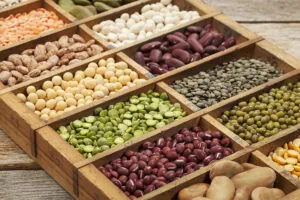
Beans have been around at least as long as we have and are one of the plants that have been cultivated the longest. Beans have been an important source of protein throughout history because on average they provide more than 9 grams of protein for only 80 calories. The term bean originally referred only to the seed of one type of bean, the fava bean but over the centuries it has expanded to include most legumes and other plants like soybeans and chickpeas. March in National Bean month and we thought it would be a great time to highlight this protein-rich dietary staple by helping you to better know your beans.
The majority of beans grown today are summer crops that require warm temperatures in order to grow. The average growing time is 55-60 days and most bean plants need external support in order to grow. Beans are not only high in protein, they are also a great source of soluble fiber and a single cup of beans provides 9-13 g of soluble fiber. The world genebank currently lists about 40,000 different varieties of beans although most of those are not currently being cultivated. To help expand your knowledge of the humble bean, we picked the most commonly used varieties to spotlight.
Black Bean
The black bean, which is also called a black turtle bean, is commonly seen in Latin American and Southwestern cuisine. Because these beans are dense with a rich texture, they are also prominent in vegetarian dishes. Black beans are much higher in calories than some of their less dense siblings with 350 calories per 3.5 oz but they also pack a ton of protein, providing 21.25 grams for that size serving.
Black Eyed Pea
Although you may not know by its name, black-eyed peas are actually considered beans because they belong to the legume family. These beans are pale in color with a large black spot.
Chickpea
Chickpeas are also legumes and may be known by several other names including garbanzo bean, ceci bean, and Bengal gram. They have been cultivated for at least 7,500 years and contain about twice as many calories, 164 per 3.5 oz, as the average bean.
Green Bean
Green beans are called by many names. They may also be referred to as string beans, snap beans, French beans, or haricots beans. Green beans are actually un-ripened pods of common beans and are much lower in both calories and protein, providing 31 calories and only 1.8 g of protein in a 3.5 oz serving.
Kidney Bean
Kidney beans are one variety of a specific type of bean called the common bean. Named because its shape resembles that of a kidney, these beans are often seen in chili, soups, and stews. Similar to black beans, kidney beans are much higher in calories, 333, and protein, 24 g, than some of their cousins.
Lentil
Lentils comes in a wide range of varieties and have been part of our culinary experience since the Neolithic period which means we have been eating them for more than 10,000 years. They can range in color from yellows to greens to reds and oranges. From a nutritional perspective, they are closest to kidney beans in terms of calories and protein.
Lima Bean
Lima beans are also known as butter beans and are distinctive amongst the most common culinary beans because of their wide flat appearance and light green color. They can be grown on both the bush and the vine and have a nutritional profile in line with the average for all beans.
Related articles
- Baked Beans: An American Original (fillyourplate.org)
- 9 Ways to Help Protect Your Heart Health (fillyourplate.org)
- 20 Easy Soup Recipes (fillyourplate.org)
30 Ways to Use Avocados

Arizonans love avocados! Maybe this is why they feature so prominently in southwestern cuisine. Also called an alligator pear, the avocado belongs to the same botanical family as cinnamon and bay laurel. It grows on trees and is native to Mexico and Central America. It frequently makes an appearance in healthy recipes because of its stellar nutritional profile. In 3.5oz of raw avocado, there are 160 calories, almost 7 grams of fiber, and a wide range of vitamins and minerals. They are higher in fat than most fruits and veggies with almost 15 g per 3.5 oz but they majority of that fat is the monounsaturated kind that is frequently considered to be “healthy fat”. Celebrate avocados this month with these fantastic recipes.
- Avocado and Pistachio Ice Cream
- Avocado and Tomato Salad
- Avocado Appetizer
- Chicken Breasts with Cheese and Chilies
- Corn and Black Bean Salsa
- Golden Beet, Fennel, and Avocado Salad
- Rasher or Buckboard Bacon Burger
- T-A-B-L-E Cosmos
- Zesty Papa Protein Scramble
- Chipotle Shrimp Taco with Avocado Salsa Verde
- Papaya Avocado Salad
- Hot Chile Grilled Pork Rounds with Avocado Mango Salsa and Couscous
- Pan Seared Tuna with Avocado, Soy, Ginger, and Lime
- Sweet Potato Oven Fries with Avocado Dip
- Avocado and Grapefruit Salad
- Avocado Hummus with Crispy Pita Chips
- Southwestern Avocado and Black Bean Salad
- Steak with Avocado Sauce and Tomato Salad
- Seven Layer Dip
- Mexican Baked Fish
- Chicken Avocado Egg Rolls
- California Chicken
- Corn, Avocado, and Tomato Salad
- Tangy Cucumber and Avocado Salad
- Carne Asada Tacos
- Kale, Quinoa, and Avocado Salad with Lemon Dijon Vinaigrette
- California Roll Salad
- Santa Fe Salad
- Grilled Salmon with Avocado Dip
- Shrimp Avocado Pasta Salad
Related articles
- 10 Things to do With Avocados (fillyourplate.org)
- All About Avocados
- What’s in Season in December? (fillyourplate.org)
Study Says Your Food Prices Could Go Up without Labor Reform
An approach to agricultural labor reform that focuses solely on immigration enforcement would raise food prices over five years by an additional 5 to 6 percent and would cut the nation’s food and fiber production by as much as a staggering $60 billion.
 Those are among the results of a report, “Gauging the Farm Sector’s Sensitivity to Immigration Reform,” conducted by World Agricultural Economic and Environmental Services. The report was commissioned by the American Farm Bureau Federation (AFBF).
Those are among the results of a report, “Gauging the Farm Sector’s Sensitivity to Immigration Reform,” conducted by World Agricultural Economic and Environmental Services. The report was commissioned by the American Farm Bureau Federation (AFBF).
By far, the best scenario for farm labor reform both for consumers and farmers is one that includes immigration enforcement, a redesigned guest worker program and the opportunity for skilled laborers currently working in agriculture to earn an adjustment of status. Under that scenario, there would be little to no effect on food prices, and the impact on farm income would be less than 1 percent.
“Arizona farmers have been asking for visa reform for over a decade,” explains Arizona Farm Bureau President Kevin Rogers. “We must have a way to grow and harvest our food; otherwise other countries will come along and do it for us. Enforcement without a worker program hurts Arizona’s agriculture industry.”
Today, U.S. agriculture depends heavily on workers who may have improper documents with no viable means of verification. Regardless of the reform scenario studied, it is clear that a legal workforce comes at a price.
“Status quo is not a viable option for anyone involved in this issue, and as a nation, we expect better,” said American Farm Bureau Federation President Bob Stallman. “Farmers and ranchers recognize there are costs to ensuring they have a legal, stable workforce. And we are willing to step up to the plate.”
The hardest-hit domestic food sectors under an enforcement-only scenario are fruit production, which would plummet by 30 to 61 percent, and vegetable production, which would decline by 15 to 31 percent. The study also pointed out that while many consider fruit and vegetable production the most labor-reliant sector, livestock production in the U.S. would fall by 13-27 percent.
 “Over five years, an enforcement-only approach would lead to losses in farm income large enough to trigger large scale restructuring of the sector, higher food prices, and greater dependence on imported products,” Stallman said.
“Over five years, an enforcement-only approach would lead to losses in farm income large enough to trigger large scale restructuring of the sector, higher food prices, and greater dependence on imported products,” Stallman said.
“With a reworked guest worker program, and by allowing skilled laborers to earn an adjustment of status, food prices would remain stable and there would only be marginal impacts on production,” Stallman said. “It’s clear that we need greater enforcement, but those two key reforms must be included in the process.
Arizona Farm Bureau conducts a quarterly marketbasket of 16 food items on behalf of Arizona families. If the study’s suggested increase of 5 to 6 percent in food prices over five years is realized, that increase would be especially high in the fruits and vegetables. “To see that type of price increase factored into our cost of food especially during inflationary food-price periods can become a true hardship for some families,” suggests Julie Murphree, spokesperson for the Arizona Farm Bureau whose department spearheads the quarterly marketbasket. “We shouldn’t have to see the consequences of no visa reform hit consumers in the pocketbook.”
 “Agriculture must feed 9 billion people by 2050 with fewer resources available,” said Arizona Farm Bureau 1st Vice President Stefanie Smallhouse. “Our government should not make this more challenging than it has to be to meet this need by ignoring our labor problems. We’re trying to make our diets healthier for our children. With the increased food prices, will this cause families to opt out of eating more fruits and vegetables?”
“Agriculture must feed 9 billion people by 2050 with fewer resources available,” said Arizona Farm Bureau 1st Vice President Stefanie Smallhouse. “Our government should not make this more challenging than it has to be to meet this need by ignoring our labor problems. We’re trying to make our diets healthier for our children. With the increased food prices, will this cause families to opt out of eating more fruits and vegetables?”
“Most Americans believe that they have outgrown farm work, which is reflected in their unwillingness to take farm jobs, even temporarily,” said Stallman. “The bottom line of this study is that we either import our labor or we import our food.”
The study compared changes in farm output, commodity prices, farm income, farm asset values, and food prices across four generic reform alternatives.
To read the study, click here.



